The AMD Radeon VII Review: An Unexpected Shot At The High-End
by Nate Oh on February 7, 2019 9:00 AM ESTProfessional Visualization and Rendering
With AMD strongly pushing the Radeon VII as a prosumer content creation card, it behooves us to look at rendering, CAD, and professional visualization performance. However, accurate and applicable benchmarks for this field are not so easy to find, especially since performance is highly dependent on workflow and proprietary licensed ISV software. Given AnandTech’s audience, which often includes engineers using these applications in critical production environments, our goal is to provide the most relevant metrics. However, as Ian has discussed previously, the route to the most accurate workstation benchmarking for professional applications is in the hands of ISVs, who are at best blasé and more typically negative about providing access, even at the prospect of lending limited software licenses in return for ongoing discussion and third-party benchmark data of their software.
Those caveats in mind, the next best thing for evaluating overall GPU workstation performance is the venerable SPECviewperf, recently updated to version 13. Separated into ‘viewsets,’ which are a group of application-specific workloads derived from real-world datasets, SPECviewperf has been a longstanding suite for generalized workstation/CAD GPU performance. For SPECviewperf 13, the viewsets are based on:
- Autodesk 3ds Max 2016 (Nitrous DX11 driver)
- Dassault Systèmes CATIA V6 R2012
- PTC Creo 3 & Creo 4
- Geosurvey software, with workloads based on rendering techniques utilized by the open-source OpendTect seismic visualization application
- Autodesk Maya 2017
- Radiological (i.e. CT, MRI scans) rendering, with workloads using the Tuvok rendering core of the ImageVis3D volume visualization application
- Autodesk Showcase 2013
- Siemens NX 8.0
- Dassault Systèmes Solidworks 2013 SP1
While we didn’t have time for complete benchmarking of video editing/production software such as Adobe Premiere Pro CC, we will be looking to include that in the future.
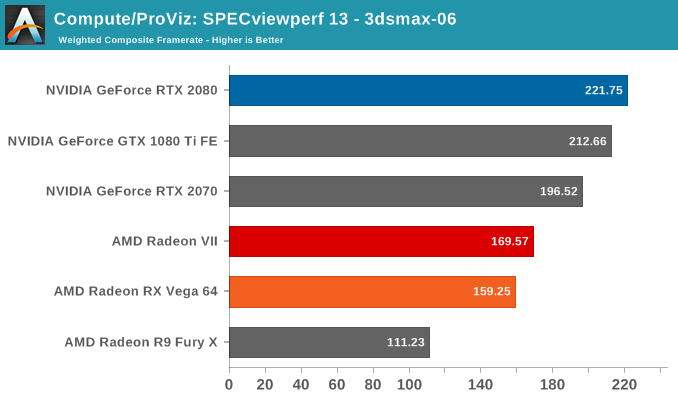
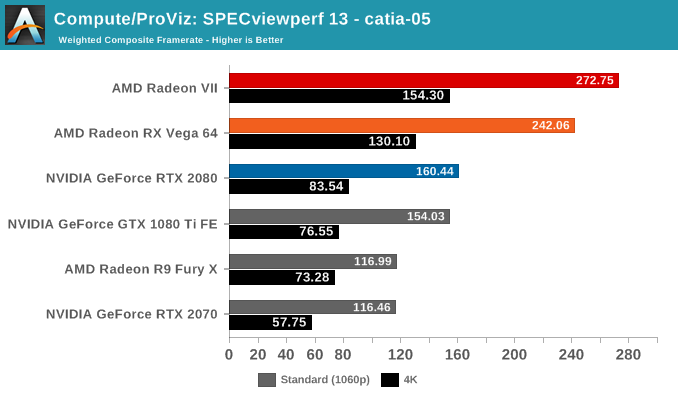

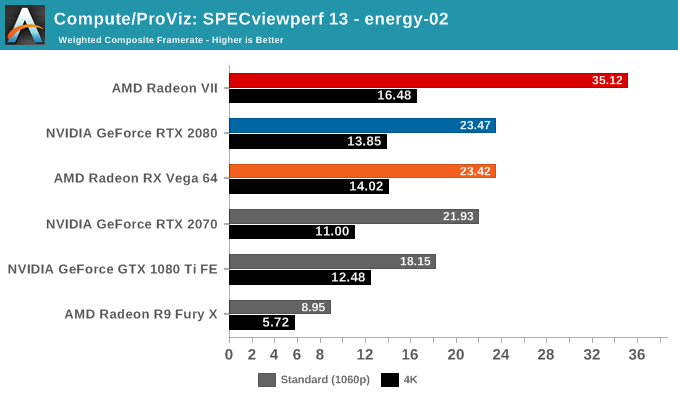
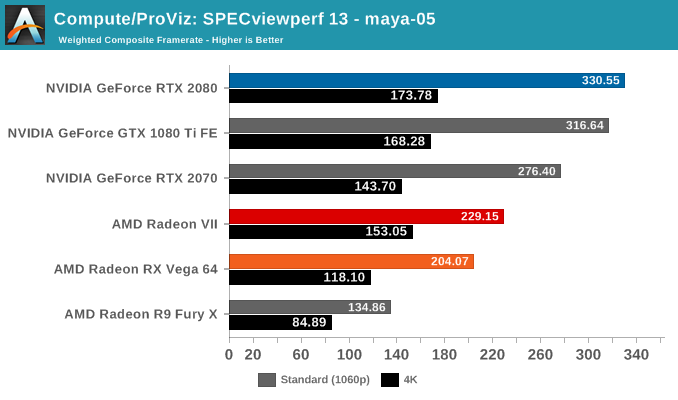
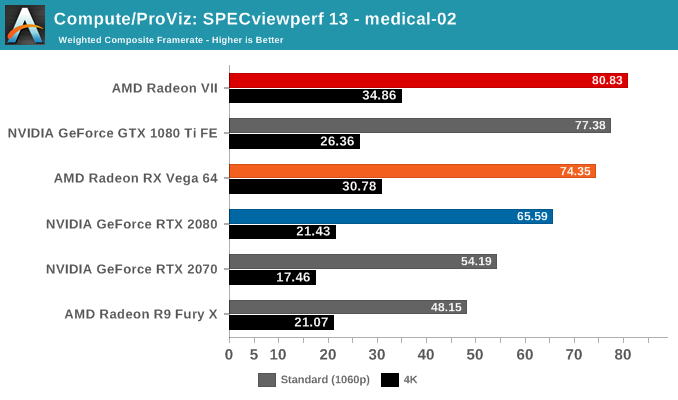
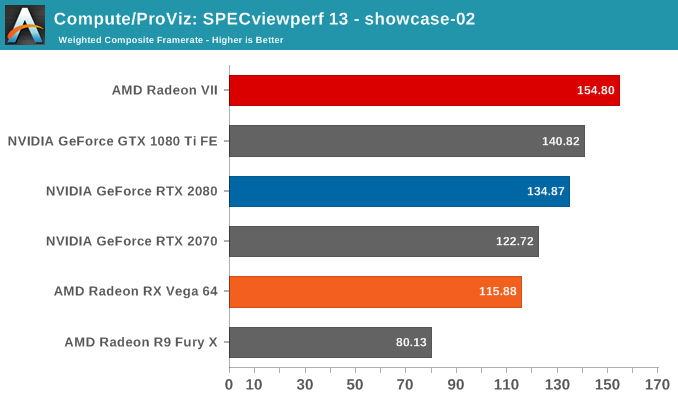
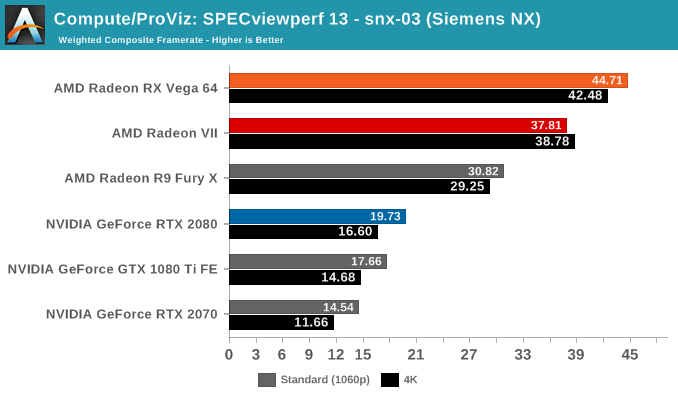
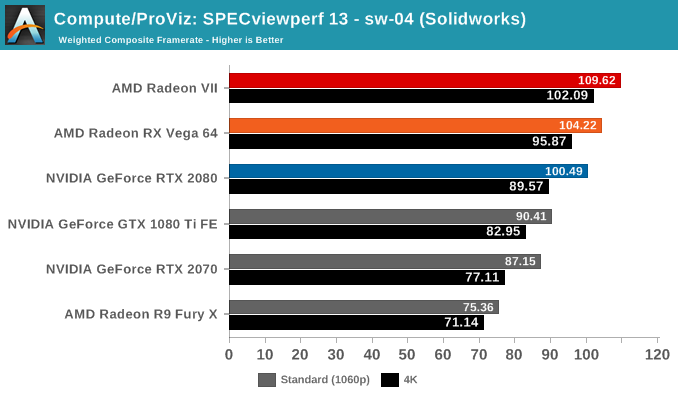
Looking over the results, it's clear that certain viewsets tend to perform better on one vendor's hardware than the other's. In those cases, the Radeon VII doesn't buck the trend, though in Siemens NX the lower performance is more likely than not related to driver maturity. In the reverse scenarios like in creo-02 or maya-05, the Radeon VII is in a similar spot, naturally ahead of the RX Vega 64 but behind the competing RTX and GTX cards. If anything, the results highlight the importance of software maturity for newer hardware, but there are definite signs of Vega 20 being a powerful workstation card. The caveat is that it doesn't seem to change the overall landscape for worksets that traditionally perform well on NVIDIA hardware.
Our next set of benchmarks look at rendering performance. To be clear, given the nature of ‘render wars’ as well as the adoption of CUDA, the featured render engines are not necessarily indicative of the overall GPU renderer landscape. Because we are looking at the Radeon VII, it’s not applicable to include some of the more popular renderers, such as Redshift and Octane, which are CUDA-only, and similarly the presence of Indigo Renderer helps as another datapoint even though it is less popular.


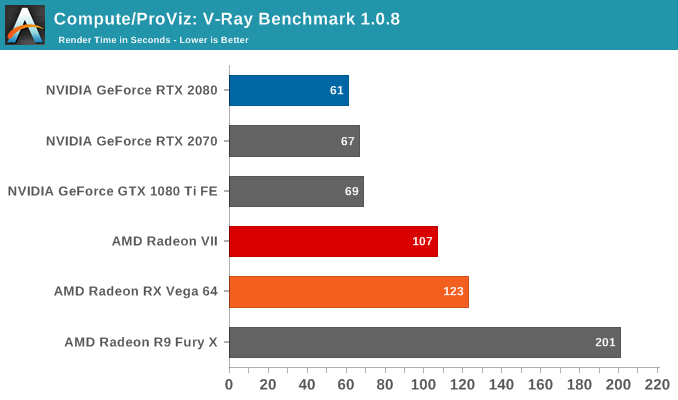

To note, official Blender releases have yet to incorporate CUDA 10, and so RTX 20 series cards are not officially supported.
V-RAY here is the only test that utilizes CUDA for NVIDIA cards, while the rest all use OpenCL. The results seem broadly similar to SPECviewperf, where the Radeon VII continues to excel at workloads where AMD hardware generally fare well.










289 Comments
View All Comments
Icehawk - Thursday, February 7, 2019 - link
FFXV results sure look CPU limited to me - why aren't you running at least an 8700 @ 5ghz?Oxford Guy - Thursday, February 7, 2019 - link
They look like GameWorks or something to me but I can't see why anyone cares about FF anyway. I hurt my face smirking when I saw the footage from that benchmark. Those hairstyles and that car... and they're going fishing. It was so bad it was Ed Wood territory, only it takes itself seriously.luisfp - Thursday, February 7, 2019 - link
People don't forget that Vega GPUs have the memory beside the GPU core, therefore making it more hot that normal GPUs out there. That has a lot to do with how hot it seems to be, the temperature tends to raise more due to memory temps in same area.just4U - Thursday, February 7, 2019 - link
True enough but owners of the 56/64 have found many work arounds to such things as the cards have not needed as much power as they push out. My cards (56s) use 220W of power per card They never go over 65c in any situation and usually sit in the high 50s to low 60s. with their undervolts.luisfp - Thursday, February 7, 2019 - link
I believe that Vega GPUs have the memory beside the GPU core, therefore making it more hot that normal GPUs out there. That might have a lot to do with how hot it seems to be, the temperature tends to raise more due to memory temps in same area.just4U - Thursday, February 7, 2019 - link
Better than a 64 in all situations and comparable to a 1080ti in all situations with only 5-6% performance hits against the 2080 which is costing 50-100 more here in Canada (according to pre-order sales) Yep, Im sold.ballsystemlord - Thursday, February 7, 2019 - link
Your favorite spelling/grammar guy is here. (AT Audience: Boo!)"Faced with a less hostile pricing environment than many were first expecting, AMD has decided to bring Vega 20 to consumers after all, duel with NVIDIA one of these higher price points."
Missing words (and & at):
"Faced with a less hostile pricing environment than many were first expecting, AMD has decided to bring Vega 20 to consumers after all, and duel with NVIDIA at one of these higher price points."
"Which is to say that there's have been no further developments as far as AMD's primitive shaders are concerned."
Verb tense problem:
"Which is to say that there's been no further developments as far as AMD's primitive shaders are concerned."
Thanks for the review!
I read the whole thing.
The F@H results for Vega are higher than I predicted (Which is a good thing!).
Ryan Smith - Thursday, February 7, 2019 - link
"Your favorite spelling/grammar guy is here. (AT Audience: Boo!)"You're always welcome here. Pull up a chair!
ballsystemlord - Friday, February 8, 2019 - link
I was joking. Some site content creators call people like me "The spelling and grammar trolls".I can never really be certain, so I try to be a little funny in hopes that no body will take my corrections as "troll" actions.
I don't know how you guys feel, but you've always taken mine and others corrections into consideration.
Ryan Smith - Saturday, February 9, 2019 - link
Our flaws and errors are our own doing. When pointed out, it's our job as journalists to correct them. So as long as people are being polite about it, we appreciate the feedback.